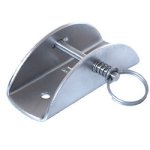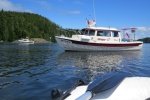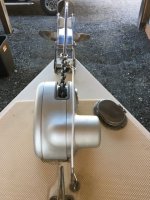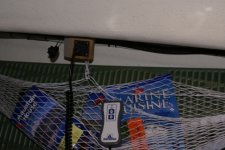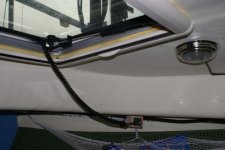tparrent
New member
- Joined
- Dec 23, 2009
- Messages
- 285
- Reaction score
- 0
- C Dory Year
- 2017
- C Dory Model
- 255 Tomcat
- Vessel Name
- Tomfoolery
I know that basic seamanship generally calls for securing the anchor and not relying on the windlass to hold it. So I set about trying to secure the anchor on my TomCat by taking a line from either the chain or the anchor itself to one of the cleats sitting either side of the windlass. Unfortunately, the angles prevent that from working. No matter how tight I pull the line, if I let even a link out of the windlass to relieve pressure, the roller tilts up in its deploying position.
Looking at it again, I figure I MIGHT be able to run a line from cleat to cleat, through the chain and pull it tight. I'll try that next trip.
However, as I was sitting on the bow looking at it, I began to wonder if I really wanted to secure it. More than once, I have had to deploy an anchor in an emergency. Each time, I was on a sailboat without a windlass so I ran to the bow, pulled the pin out of the roller and let the rode run free. Any delay could have cost me the boat.
To be fair, I was also on a big sailboat heading out the St Lucie inlet once in wicked conditions and the anchor was NOT secured (not my boat) and it went overboard at the worst possible time. Almost pitchpoled us backwards before the rode snapped.
Here's the issue as I see it. On the TomCat, if I had the anchor tied down and needed to deploy it in an emergency, I would have to exit the cabin, slide along the gunwale in conditions that almost by definition wouldn't be good, untie the line, go back along the side of the cabin, reenter and finally release the windlass.
That's a lot of time and movement when things are getting sporty.
I could not figure out how to release the windlass while AT the windlass. May need to investigate that but I see lots of broken finger possibilities (on the other hand, if I lose power at the wrong time, I wouldn't have a way to release the anchor without some sort of override).
Balancing risks, it seems to me that it might be safer to simply leave the anchor unsecured and rely on that beefy windlass to hold it - but I am open to being corrected on that.
Of course, another obvious backup plan would involve having a second anchor ready to deploy from the cockpit in an emergency. I've almost always had a spare anchor on board my boats. If I can figure out how to stow a second one in a ready to go condition, then I would secure the bow anchor.
How do you all handle this?
Is there a way to manually release the windlass?
Thanks
Looking at it again, I figure I MIGHT be able to run a line from cleat to cleat, through the chain and pull it tight. I'll try that next trip.
However, as I was sitting on the bow looking at it, I began to wonder if I really wanted to secure it. More than once, I have had to deploy an anchor in an emergency. Each time, I was on a sailboat without a windlass so I ran to the bow, pulled the pin out of the roller and let the rode run free. Any delay could have cost me the boat.
To be fair, I was also on a big sailboat heading out the St Lucie inlet once in wicked conditions and the anchor was NOT secured (not my boat) and it went overboard at the worst possible time. Almost pitchpoled us backwards before the rode snapped.
Here's the issue as I see it. On the TomCat, if I had the anchor tied down and needed to deploy it in an emergency, I would have to exit the cabin, slide along the gunwale in conditions that almost by definition wouldn't be good, untie the line, go back along the side of the cabin, reenter and finally release the windlass.
That's a lot of time and movement when things are getting sporty.
I could not figure out how to release the windlass while AT the windlass. May need to investigate that but I see lots of broken finger possibilities (on the other hand, if I lose power at the wrong time, I wouldn't have a way to release the anchor without some sort of override).
Balancing risks, it seems to me that it might be safer to simply leave the anchor unsecured and rely on that beefy windlass to hold it - but I am open to being corrected on that.
Of course, another obvious backup plan would involve having a second anchor ready to deploy from the cockpit in an emergency. I've almost always had a spare anchor on board my boats. If I can figure out how to stow a second one in a ready to go condition, then I would secure the bow anchor.
How do you all handle this?
Is there a way to manually release the windlass?
Thanks



